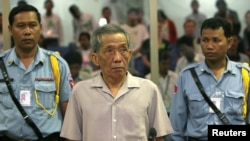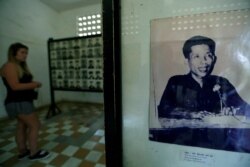Cambodians greeted the death of Khmer Rouge commandant Kaing Guek Eav – also known as Duch – with a mix of happiness, sorrow and relief, as this country continues to move on from its tragic past.
Duch died on September 2, while serving a life sentence at the Kandal Provincial Correctional Center for crimes against humanity and the deaths of more than 16,000 people in Cambodia’s notorious Killing Fields between 1975 and 1979.
His conviction was one of three obtained at a United Nations-backed court, which found the former math teacher and born again Christian had ruthlessly lorded over prisoners he deemed fit for extermination at S-21, a prison converted from a high school at Tuol Sleng in the capital city of Phnom Penh.
By 1971 he had already established a prototype torture center, which would serve as a model for 196 such camps across Cambodia once Khmer Rouge leader Pol Pot had seized control of the country four years later.
His techniques included electrification and disembowelment.
Children were taken from their mothers, prisoners were left chained to rotting corpses for days in the tropical heat. Meals were rare, beatings were common and death inevitable.
They were then taken to the Killing Fields of Choeung Ek on the outskirts of Phnom Penh.
Shortly after Duch died, Chhay Hoc Pheng, an author and retired French judge, was paying his respects to relatives who perished under Pol Pot at Choeung Ek, where most of Duch’s prisoners would meet a violent end.
“I believe that the souls of people who die here will definitely ask Duch: ‘Why did you kill us? Why try to destroy us? What did we do wrong?’ he said.
“I believe Duch will go where he deserves to go because of the deadly sins he committed. I do not mean this out of revenge or anger but it is the truth,” said the author of Genocide Orphans.
Some of his prisoners were Westerners who – like at least 5,000 others – were forced to confess.
One former guard testified that an Australian was shackled and taken outside the gates of S-21 where he was made to sit as a tire drenched in gasoline was pulled over him and lit on fire.
Americans Michael Deeds and Christopher DeLance were among the last to be executed, shortly before a Vietnamese invasion ousted the Khmer Rouge from Phnom Penh in January 1979, forcing Pol Pot into the countryside where a civil war continued for another two decades.
Canadians, New Zealanders, and Britons also perished.
Rob Hamill is a New Zealander whose family was torn apart after learning his brother, Kerry, was captured by the Khmer Rouge and perished along with a handful of other Westerners at S-21.
“He effectively ran the secret police. He developed the system. He was the mathematical genius who created the killing machine that the rest of the country followed,” Hamill said after Duch was jailed for life in 2012.
The U.N.-backed court heard Duch had established M-13, a previously unknown death camp, as a prototype in a communist-held zone in 1971, when Pol Pot's forces were still battling the U.S.-backed Lon Nol government for control of the country.
Duch told the court, from behind a wall of bullet-proof glass, that M-13 was designed to “detain, to torture and to smash, that is to kill” and it was here that Duch was “happy like a madman” when torturing prisoners.
One M-13 worker testified that he watched Duch hang a woman from a tree, strip off her shirt and burn her breasts with a lit kerosene rag.
Mao Thel has worked as a grave keeper at Choeung Ek since 1980 and says Cambodians were happy and relieved that nearly all senior leaders of the Khmer Rouge had died. Both of his parents died of starvation under Pol Pot.
“The People who see that he died are happy because Cambodians don’t like the Khmer Rouge. People are angry because the Khmer Rouge killed all their families, he said. “My mother and father died, starving of food, my mother -- my father… today only one, me.”
While many older Cambodians remain haunted by Pol Pot, the Khmer Rouge tribunal and the passing of those responsible for the slaughter of about two million people has enabled this once troubled country to move ahead, despite its tragic past.
Ny Chann contributed to this report.






